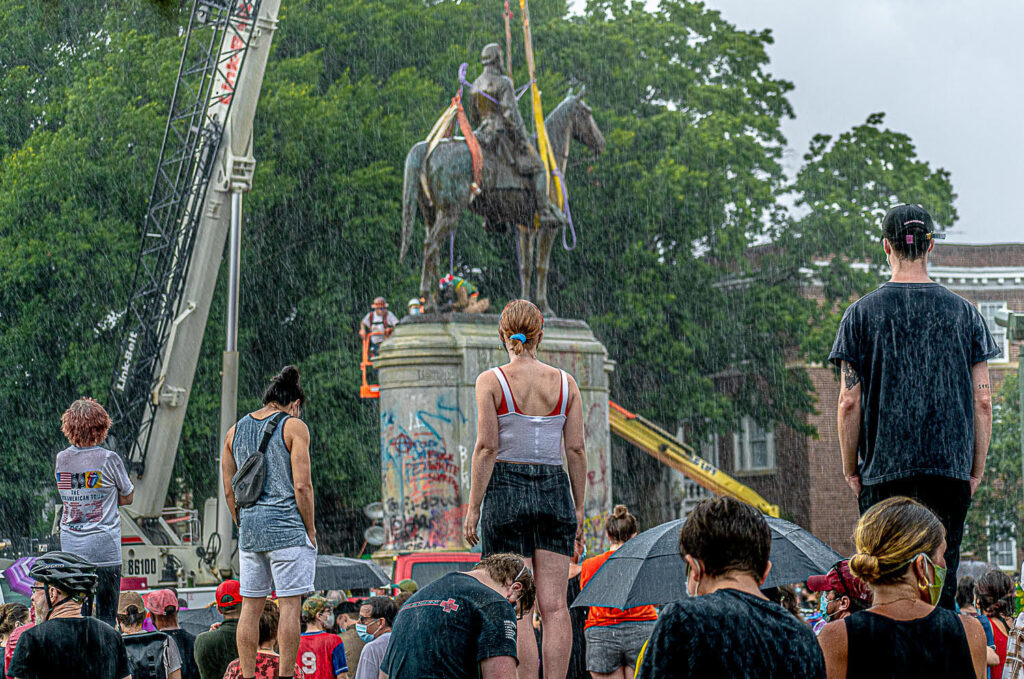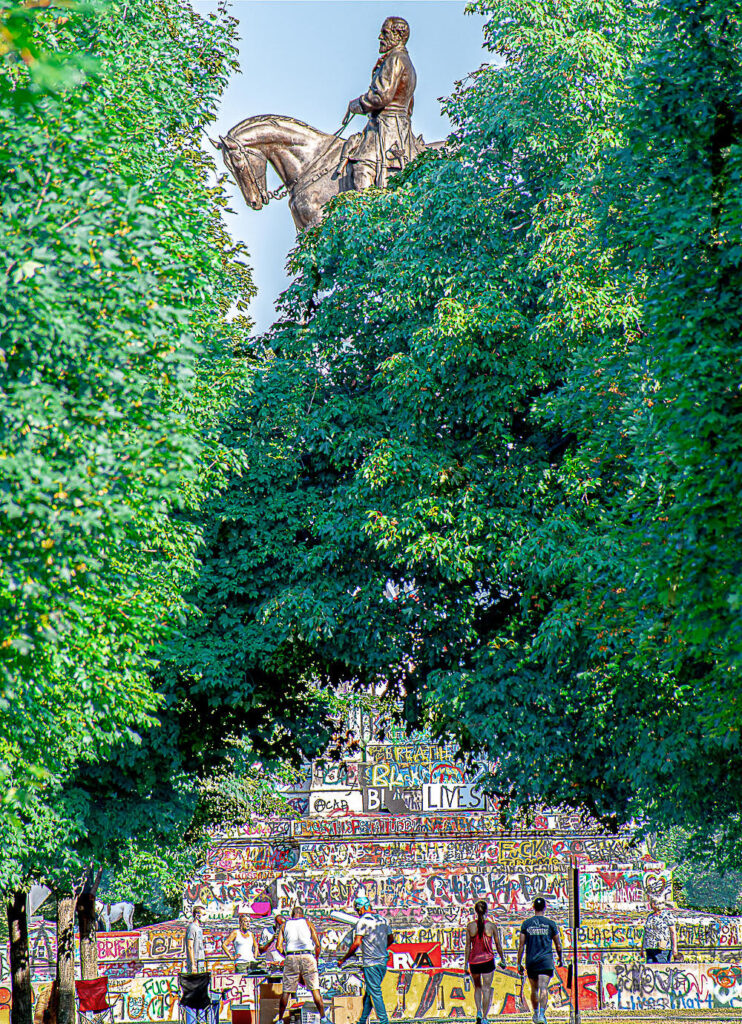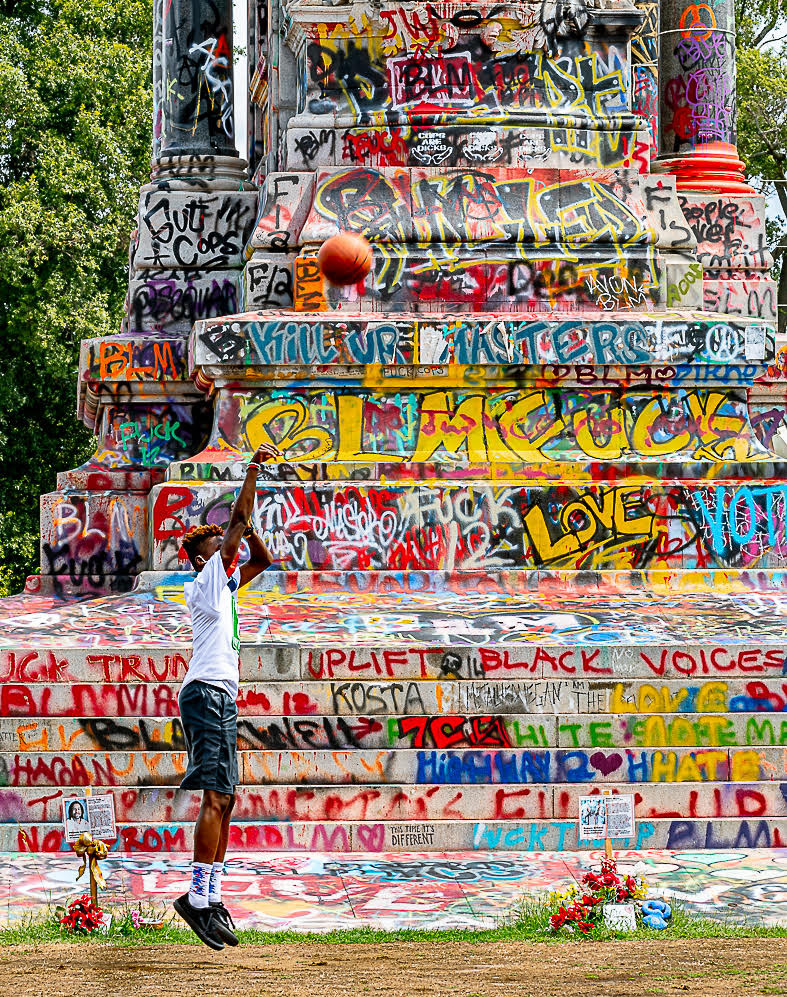Derek Kannemeyer has spent most of his life as a poet, writer and teacher. He was born in 1949 in South Africa. In 1956 his family moved to London to escape the brutal atmosphere of South African apartheid. He has resided in the US since 1975.
A few years ago Kannemeyer began photographing street scenes in Richmond, Virginia as well as what remains of the natural world in the city, particularly along the banks of the James, the river that dramatically bifurcates the city. And then the Black Lives Matter protests happened last year, an event that has effected the city’s landscape in an altogether different way.
Kannemeyer set about to visually document how these protests led to the dramatic removal of the city’s iconic Civil War statues. Almost all of these statues were erected in the Jim Crow era early in the last century. The photographs here are just a small sample of the ones that will appear in Kannemeyer’s “Unsay Their Names,” a book of essays and photography that will see publication later this year. —Ed Cowardin
In Unsay Their Names: The Colorful Fall From Grace of a City’s Statuary, I document the changing face of Richmond, Virginia in the wake of George Floyd’s death, and the ensuing Black Lives Matter protests. As, across the country, outcry hardened into action, the causes broadened; the targets became local. In Richmond, spray-paint transformed the city’s statues. Two easy to reach Confederate effigies were flung to the ground. Columbus was pitched into a lake. The city hired contractors with cranes to cart off a half-dozen others. Support for the policy was strong, even impatient (Trump won only 15% of the vote here); the mood at the statue removals was festive.

July, Jackson
The first statue removed by the city was Stonewall Jackson’s, on July 1st. The contractor, afraid for his life, wore a bullet-proof vest. But the crowd—predominantly white—was patient, and very supportive. The work crew took several hours to get this first operation right, and by the end blue skies had blackened into rainstorm. We witnesses remained, drenched, motionless, waiting to erupt into applause.
At the center of the action was Monument Avenue. A hundred years ago, the street was created as a showcase for Lost Cause statues. By 1925, there were five of these, each towering over a traffic circle. The Lee Memorial, the first to be erected, was their centerpiece. With its great grassy verge, it was also the only one where visitors could gather and loiter. And soon, the activists, the pilgrims, the tourists—ordinary Richmonders of all stripes who wished to bear witness—were doing exactly that.
These people, and the city’s remade spaces, are the subjects of my photographs. I wished to construct a narrative of social history in the making. But this is also a book of commentary. I wanted to research and to reflect: to know more about the names we were saying and unsaying, and about what brought us to our summer of reckoning. I appended dozens of short articles, illustrated by photographs, and I told some of my own story, which fits startlingly well within my larger tale. But then —our American history being what it is—so, I suspect, would yours. G&S

July, Lee (above)
By July there were tee-shirt vendors, and booths where you could register to vote. There were free classes, and creative protests; as the activists moved in, it became a well-organized events venue. The pilgrims still flocked here, but so did the tourists. On the walls, the painted slogans overlapped and thickened, outshouting each other for attention.

August/November, Lee (above)
By late summer, Lee was the last Monument Avenue Confederate left standing. This is not city-owned land, and the state, having ordered the statue removed, still faces legal opposition. But the authorities were now giving the activists free rein. During the day, there were fewer late year visitors: casual strollers, mostly, and hoopers, and crunchy activists, some tending the burgeoning vegetable gardens. It was an affably occupied zone. The graffiti, continuing to thicken, remained lovely, even if in places it looked as if it had seen too many dye jobs.
To order books: derekkannemeyer@gmail.com





[…] to get what they want — the erasure of history. They even developed the Orwellian phrase, “Unsay Their Names.” These statues paid homage to racial bigotry, so they became the “people who stand up against […]